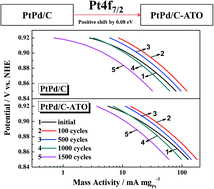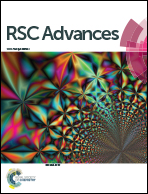Highly effective oxygen reduction activity and durability of antimony-doped tin oxide modified PtPd/C electrocatalysts
Abstract
Antimony-doped tin oxide (ATO) nanoparticles are synthesized by a simple one-step hydrothermal method. The oxygen reduction reaction (ORR) activity of the PtPd/C catalyst is promoted by the presence of ATO. Moreover, after accelerated durability testing, the PtPd/C-ATO catalyst reserves most of its electrochemically active surface area (ESA) and ORR activity compared to the PtPd/C catalyst. The improved electrochemical stability and activity of PtPd/C-ATO is attributed to the high stability of ATO support and the strong interaction between Pt and ATO.


 Please wait while we load your content...
Please wait while we load your content...